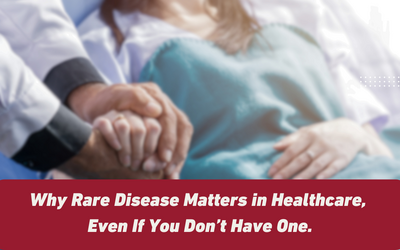
People who are managing a rare disease have a unique view of the healthcare system. Their journeys to diagnoses and treatment are often very different from those managing more common diseases like arthritis or diabetes.
We also know that however rare any individual disease may be, cumulatively, rare diseases are not that rare - and neither are the challenges.
According to the National Council of State Legislatures, "In the United States, a disease is defined as rare when fewer than 200,000 Americans are affected." Estimates on the number of rare diseases range between 7,000 and 10,000 with children and young adults making up the majority of those affected.
It all starts with their diagnostic journey. We asked our patient ambassadors: "What is one thing you wish people would understand about life with a rare disease?"
- "How hard it is to get a diagnosis. I saw 15 doctors over the course of almost 10 years before I got a diagnosis." - Graceson Mahoney
- "How unpredictable it can be. One day you are fine enough and the next day you can't get out of bed. All plans are made knowing they may be canceled last minute. Every day is hard, but I am resilient." - Kristin Moore Klontz
- "That it's not a one-size-fits-all disease." - Kaye Spalding Peterson
- "I have a few and I find my doctors in general don't understand and don't think about how my general healthcare is affected by my rare ones...I wish I could be heard and I wish I had better access to doctors who do understand rare diseases. I have to use a concierge telehealth service...because locally, they don't 'see' me and my rare things." - Anna Williams
Unfortunately, that is just the beginning. Starting with their diagnostic journey, challenges include advocating for oneself with providers, finding experts in the field, and getting access to affordable and effective treatments. What's more, that doesn't even capture the work that patients have to do to communicate all this to friends, family members and employers.
The Chronic Disease Coalition advocates for more access, affordability and representation in healthcare because these are the issues that affect patients the most.
Representation in policymaking is also essential. Their disease is rare; their experience is not. By integrating rare disease patients into policy decisions through advisory councils, patient advocacy groups, and direct involvement, we can build a better healthcare system that helps all of us. Early diagnosis of any disease will lead to earlier, more effective interventions that preserve people's ability to be active in work, family and community life.
Christina Thielst, a member of the Chronic Disease Coalition Patient Advisory Council and a member of Nevada's Rare Disease Advisory Council, shared this:
"Through the Nevada Rare Disease Coalition, I find community and learn ways to better advocate for both rare and non-rare diseases...especially on public policy. Our shared goal is to feel heard and understood! In general, the RDACs highlight the issues those of us face with a rare disease, but many of our concerns can apply to any disease. For example, a neurologist being too focused on the common to see variants in their patients. We are not all alike, no matter our disease. But, the risk for rare is a higher likelihood that we will be sidelined and perhaps feel like our illness must be in our own mind. That is until we find the right doctor or nurse who will listen and take us seriously and not give up on finding the cause of our symptoms. Most importantly, we find we are not alone...anymore."
Accessibility is another key issue, as Christina lays out above. Many patients struggle to find specialists, undergo timely diagnoses, or access necessary treatments due to geographic and systemic constraints. Needed improvements include investments in telemedicine, decentralized care networks that enable access to specialists, and physician education to improve rare disease diagnosis and treatment availability.
Affordability is a significant challenge for rare disease patients and families, as many treatments are prohibitively expensive due to limited research, small patient populations, and high development costs.
Healthcare reform must ensure that life-saving medications and treatments are financially accessible, whether through expanded insurance coverage, price regulation, or public-private partnerships that lower costs.
And that shouldn't be rare.
Ready to take action?
You can send a message to your legislator or federal representative right from our website. You can even add your own story or modify the message to reflect your experience and needs. Elected officials need to hear from their constituents, and this is an easy, efficient way to do it.